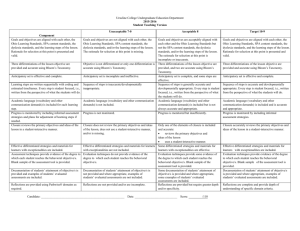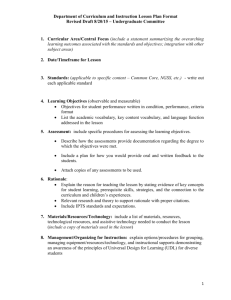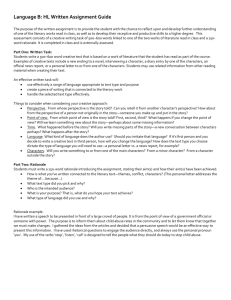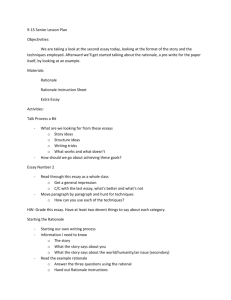Pre-Student Teaching Lesson Plan Rubric 2015-16
advertisement
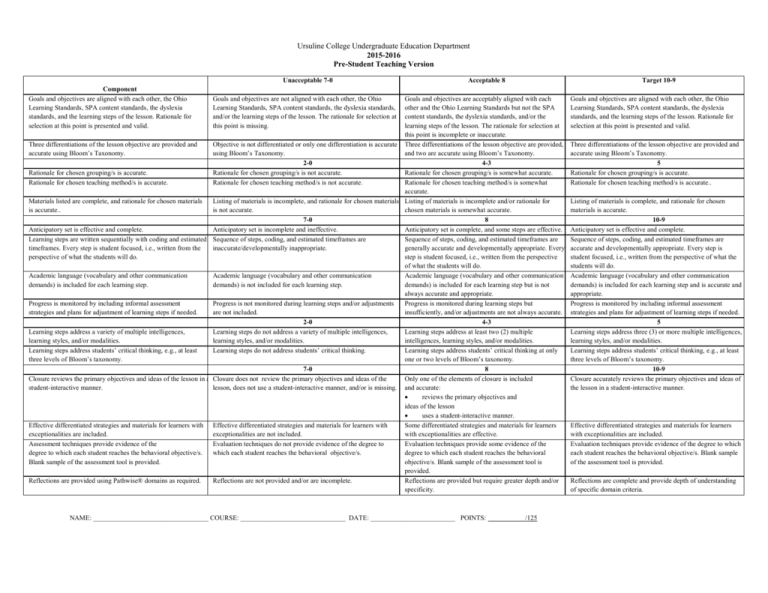
Ursuline College Undergraduate Education Department 2015-2016 Pre-Student Teaching Version Unacceptable 7-0 Component Goals and objectives are aligned with each other, the Ohio Learning Standards, SPA content standards, the dyslexia standards, and the learning steps of the lesson. Rationale for selection at this point is presented and valid. Acceptable 8 Target 10-9 Goals and objectives are not aligned with each other, the Ohio Learning Standards, SPA content standards, the dyslexia standards, and/or the learning steps of the lesson. The rationale for selection at this point is missing. Goals and objectives are acceptably aligned with each other and the Ohio Learning Standards but not the SPA content standards, the dyslexia standards, and/or the learning steps of the lesson. The rationale for selection at this point is incomplete or inaccurate. Three differentiations of the lesson objective are provided and Objective is not differentiated or only one differentiation is accurate Three differentiations of the lesson objective are provided, accurate using Bloom’s Taxonomy. using Bloom’s Taxonomy. and two are accurate using Bloom’s Taxonomy. 2-0 4-3 Rationale for chosen grouping/s is accurate. Rationale for chosen grouping/s is not accurate. Rationale for chosen grouping/s is somewhat accurate. Rationale for chosen teaching method/s is accurate. Rationale for chosen teaching method/s is not accurate. Rationale for chosen teaching method/s is somewhat accurate. Materials listed are complete, and rationale for chosen materials Listing of materials is incomplete, and rationale for chosen materials Listing of materials is incomplete and/or rationale for is accurate.. is not accurate. chosen materials is somewhat accurate. 7-0 8 Anticipatory set is effective and complete. Anticipatory set is incomplete and ineffective. Anticipatory set is complete, and some steps are effective. Learning steps are written sequentially with coding and estimated Sequence of steps, coding, and estimated timeframes are Sequence of steps, coding, and estimated timeframes are timeframes. Every step is student focused, i.e., written from the inaccurate/developmentally inappropriate. generally accurate and developmentally appropriate. Every perspective of what the students will do. step is student focused, i.e., written from the perspective of what the students will do. Academic language (vocabulary and other communication Academic language (vocabulary and other communication Academic language (vocabulary and other communication demands) is included for each learning step. demands) is not included for each learning step. demands) is included for each learning step but is not always accurate and appropriate. Progress is monitored by including informal assessment Progress is not monitored during learning steps and/or adjustments Progress is monitored during learning steps but strategies and plans for adjustment of learning steps if needed. are not included. insufficiently, and/or adjustments are not always accurate. 2-0 4-3 Learning steps address a variety of multiple intelligences, Learning steps do not address a variety of multiple intelligences, Learning steps address at least two (2) multiple learning styles, and/or modalities. learning styles, and/or modalities. intelligences, learning styles, and/or modalities. Learning steps address students’ critical thinking, e.g., at least Learning steps do not address students’ critical thinking. Learning steps address students’ critical thinking at only three levels of Bloom’s taxonomy. one or two levels of Bloom’s taxonomy. 7-0 8 Closure reviews the primary objectives and ideas of the lesson in a Closure does not review the primary objectives and ideas of the Only one of the elements of closure is included student-interactive manner. lesson, does not use a student-interactive manner, and/or is missing. and accurate: reviews the primary objectives and ideas of the lesson uses a student-interactive manner. Effective differentiated strategies and materials for learners with Effective differentiated strategies and materials for learners with Some differentiated strategies and materials for learners exceptionalities are included. exceptionalities are not included. with exceptionalities are effective. Assessment techniques provide evidence of the Evaluation techniques do not provide evidence of the degree to Evaluation techniques provide some evidence of the degree to which each student reaches the behavioral objective/s. which each student reaches the behavioral objective/s. degree to which each student reaches the behavioral Blank sample of the assessment tool is provided. objective/s. Blank sample of the assessment tool is provided. Reflections are provided using Pathwise® domains as required. Reflections are not provided and/or are incomplete. Reflections are provided but require greater depth and/or specificity. NAME: __________________________________ COURSE: _______________________________ DATE: _________________________ POINTS: /125 Goals and objectives are aligned with each other, the Ohio Learning Standards, SPA content standards, the dyslexia standards, and the learning steps of the lesson. Rationale for selection at this point is presented and valid. Three differentiations of the lesson objective are provided and accurate using Bloom’s Taxonomy. 5 Rationale for chosen grouping/s is accurate. Rationale for chosen teaching method/s is accurate.. Listing of materials is complete, and rationale for chosen materials is accurate. 10-9 Anticipatory set is effective and complete. Sequence of steps, coding, and estimated timeframes are accurate and developmentally appropriate. Every step is student focused, i.e., written from the perspective of what the students will do. Academic language (vocabulary and other communication demands) is included for each learning step and is accurate and appropriate. Progress is monitored by including informal assessment strategies and plans for adjustment of learning steps if needed. 5 Learning steps address three (3) or more multiple intelligences, learning styles, and/or modalities. Learning steps address students’ critical thinking, e.g., at least three levels of Bloom’s taxonomy. 10-9 Closure accurately reviews the primary objectives and ideas of the lesson in a student-interactive manner. Effective differentiated strategies and materials for learners with exceptionalities are included. Evaluation techniques provide evidence of the degree to which each student reaches the behavioral objective/s. Blank sample of the assessment tool is provided. Reflections are complete and provide depth of understanding of specific domain criteria.
